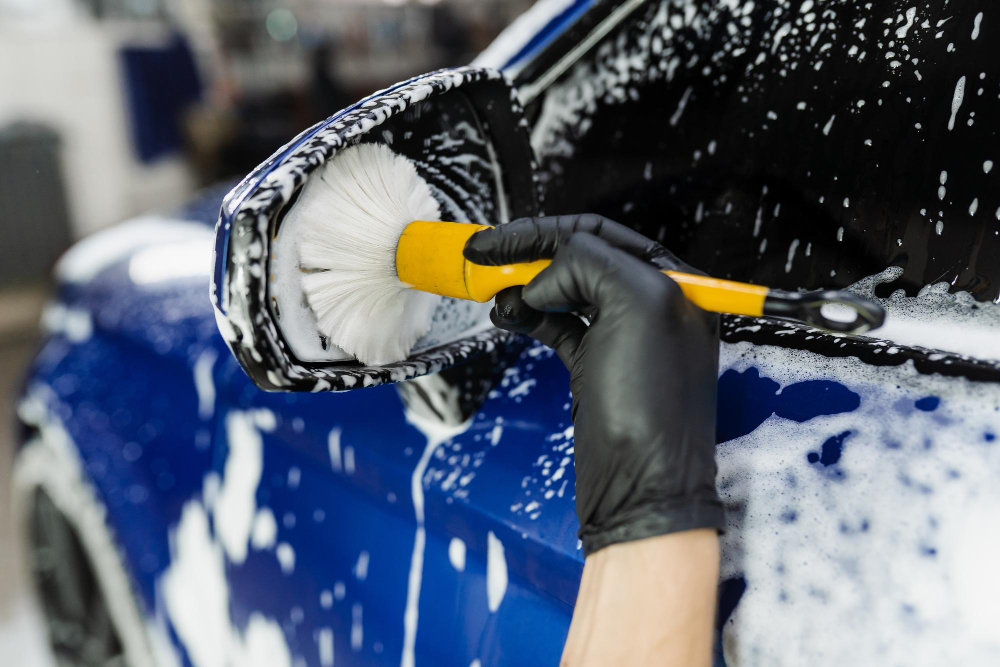Maintaining your car in pristine condition requires regular servicing and cleaning. Everyone desires that new showroom look, and detailing is the way to achieve it.

This procedure involves thorough cleaning of the bodywork, exterior trim, wheels, and glass, along with adding a protective layer against the elements. Although it is more time-consuming and labour-intensive than a regular wash, the rewards for you and your car are well worth it.
Car owners can opt for professional detailing services, but these can be costly. Fortunately, with a wide range of affordable exterior car care products readily available, many people choose to do the work themselves. With the best exterior detailing products and a few handy tips, anyone can handle scratches, dents, and eyesores, achieving results that meet or even exceed professional detailing services.
Why Exterior Detailing is a Necessity
Detailing goes beyond regular cleaning by addressing every inch of your car. It not only removes dust, stains, and road debris but also adds a wax and polish layer to keep the metal shining longer. This deeper clean ensures every component is thoroughly cleaned, restored, and preserved, preventing advanced wear on cars exposed to the elements.
Detailing addresses issues that can pose long-term problems, such as rust build-up, scratches, and flaking paint. It shields the glass and removes contaminants like brake pad dust from the wheels. The aim is to preserve your investment and retain your car’s value. Removing dust and ingrained contaminants also prevents potential mechanical or electrical issues, aids car performance, and enhances safety and visibility. Consistency in detailing, much like regular maintenance, brings the best results.
Required Products and How It’s Done
At a fraction of the cost of pro detailing, carefully formulated products deal with different materials and surfaces. And they’re applied at set stages. Here’s what you need:
- Pre-wash foam and a decent car shampoo
- Mitts, cloths and drying towels to dig deeper and remove swirl marks
- A pair of buckets, one for clean, the other for dirty water
- Wheel cleaner
The gear comprises the first cleaning stage. Here you’ll also want a pressure washer with matching lance to evenly apply the foam and speed things up when rinsing. Start with the wheels, as they are often the dirtiest part of the car, picking up mud and debris from the road. Spray a pre-wash foam to break down dirt, grease, and brake dust, let it sit for a few minutes, then rinse. Use microfibre mitts for intricate alloy designs and brushes for tight spots.
Next, inspect for scratch and dent marks, noting any damage to the paintwork. Apply pre-wash foam from top to bottom to break down stubborn particles. Let the foam sit for a couple of minutes to reduce water stains and swirl marks during rinsing. Ensure you cover detailed areas like panel gaps, the grille, and mirrors.
The critical hand wash stage follows. Here, buckets, mitts, and shampoo do most of the work. Car shampoos handle remaining contaminants, are pH neutral to be gentle on paint and coatings, and come in matte or gloss finishes. Apply shampoo with mitts from top to bottom, rinsing and cleaning mitts as needed, then dry with clean towels.
Prepping the Paintwork
This is where exterior detailing differs most from cleaning. The stage is crucial before any wax or polish is applied and deals with embedded contaminants, leftover stains or residue and surface damage that is still there even after a deep clean. Here you’ll need varied products depending on the condition of the car and the scale of damage. For instance, clay bars deal with rough surfaces in the paintwork, iron fallout remover gets to brake dust and limescale removers handle residue and swirls. Other items are birdlime remover for cars parked on the street, and tar remover if you’ve encountered roadworks while driving.
Polishing and Waxing
Polishing and waxing provide lasting protection. For comprehensive protection against UV rays, pooling water, road debris, and other contaminants, seek the best exterior detailing products. Polish always comes first.
General-purpose polishes handle most damage, including surface scratches and swirl marks, and contain moderate abrasives. They are best applied by hand with pads or mitts. Follow up with glaze polish or filler if you plan to apply wax. These products enhance the car’s appearance, providing a glossy sheen. More abrasive polishes, used with machine polishers, handle deeper scratches.
Waxes and sealants add a protective layer against external factors. Natural waxes increase sheen but require frequent application for lasting results. Synthetic waxes last longer but offer a more subdued look. Most waxes come as paste and are applied with pads, but there are simple spray-on types too. Sealants prevent UV rays, acid rain, bug spatter, and bird droppings from damaging the paint and add a lasting gloss shine.
Finishing Touches
Rubber trim lining, the window glass and details, like the lights and plates all need attention for a rounded look. Use spray-on glass cleaner to good effect on windscreens and windows without forgetting the mirrors; general-purpose or quick detailers for plastic and rubber trim elements and number plates; and dab some tyre dressing to bring the wheels back to life.
Shopping for car exterior detailing products is straightforward, either in-store or online. Buyers can get products separately or packaged and save some cash. Exterior detailing usually follows the interior. Ensure you set a few hours for the job, have the car in the shade and detail your vehicle on a dry day. When you’re done, take a step back and enjoy the results.

